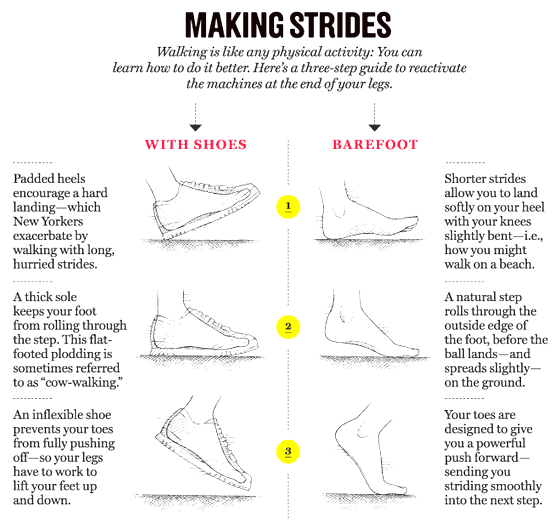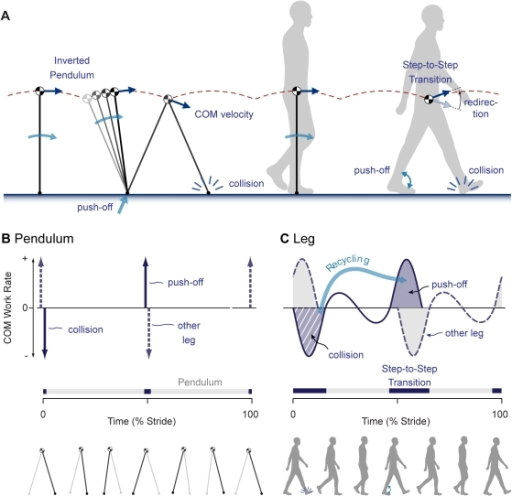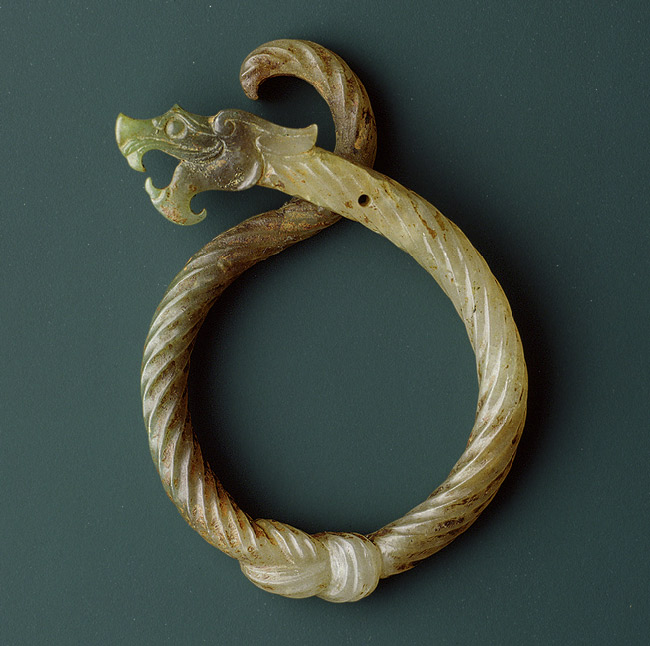How we walk
21 posts • Page 1 of 2 • 1, 2
How we walk
Forgive me if this is a topic which has been covered before. I remember reading an article some time ago regarding how we humans walk in relation to how pre humans, homo erectus etc..walked. If I remember correctly the conclusion it came to was that we walk very inefficiently with the pitch and fall motion whereas pre humans did not do this but rather the weight of the foot was planted as a whole. This made me think of bagua walking and how this works to maintain a root and centre of balance. I cant seem to find anything on this anymore but was wondering if anybody had any views or additional info.
Cheers
Cheers
Last edited by Mr_Wood on Fri Mar 18, 2016 12:25 pm, edited 1 time in total.
The sky will punish you
-

Mr_Wood - Great Old One
- Posts: 1994
- Joined: Thu Nov 19, 2009 11:13 pm
Re: How we walk
Mr_Wood wrote:Forgive me if this is a topic which has been covered before. I remember reading an article some time ago regarding how we humans walk in relation to how pre humans, homo erectus etc..walked. If I remember correctly the conclusion it came to was that we walk very inefficiently with the pitch and fall motion whereas pre humans did not do this but rather the weight of the foot was planted as a whole. This made me think of bagua walking and how this works to maintain a root and centre of balance. I cant seem to find anything on this anymore but was wondering if anybody had any views or additional info.
Cheers
now that's interesting and will work when training taiji.
thanks, that's a good one, will try it.
- willie
Re: How we walk
Mr_Wood wrote:Forgive me if this is a topic which has been covered before. I remember reading an article some time ago regarding how we humans walk in relation to how pre humans, homo erectus etc..walked. If I remember correctly the conclusion it came to was that we walk very inefficiently with the pitch and fall motion whereas pre humans did not do this but rather the weight of the foot was planted as a whole. This made me think of bagua walking and how this works to maintain a root and centre of balance. I cant seem to find anything on this anymore but was wondering if anybody had any views or additional info.
Cheers
So what happened to the pre humans

Are you suggesting that evolution would favor and support an in-efficient mode of locomotion?
I would think the other way around, that many of the stepping in IMA are designed to enhance certain things but are not generally better then
what would be consider to be normal walking.
Rather, the bipedal adaptation hominines had already achieved was used in the savanna. The fossil record shows that early bipedal hominines were still adapted to climbing trees at the time they were also walking upright. It is possible that Bipedalism evolved in the trees, and was later applied to the Savannah as a vestigial trait. Humans and orangutans are both unique to a bipedal reactive adaptation when climbing on thin branches, in which they have increased hip and knee extension in relation to the diameter of the branch, which can increase an arboreal feeding range and can be attributed to a convergent evolution of bipedalism evolving in arboreal environments.
[45] Hominine fossils found in dry grassland environments led anthropologists to believe hominines lived, slept, walked upright, and died only in those environments because no hominine fossils were found in forested areas. However, fossilization is a rare occurrence—the conditions must be just right in order for an organism that dies to become fossilized for somebody to find later, which is also a rare occurrence. The fact that no hominine fossils were found in forests does not ultimately lead to the conclusion that no hominines ever died there.
https://en.wikipedia.org/wiki/Bipedalism
As many have said the practice of IMA is a different way of moving directed at achieving certain skill sets.
That it may improve on ones gait over other types of exercises , maybe more of a side benefit
Last edited by windwalker on Fri Mar 18, 2016 4:33 pm, edited 1 time in total.
- windwalker
- Wuji
- Posts: 10634
- Joined: Sun Mar 25, 2012 4:08 am
Re: How we walk
So what happened to the pre humans
my guess, we killed them.
Are you suggesting that evolution would favor and support an in-efficient mode of locomotion?
Does sitting at a computer desk all day do anyone any good ? The way we are evolving must certainly have to factor this in.
Last edited by Mr_Wood on Fri Mar 18, 2016 4:44 pm, edited 1 time in total.
The sky will punish you
-

Mr_Wood - Great Old One
- Posts: 1994
- Joined: Thu Nov 19, 2009 11:13 pm
Re: How we walk
I read the locking of the knees which most of us do, over time has an impact. The Pitch and fall is very efficient for running, it propels the body forward.
The sky will punish you
-

Mr_Wood - Great Old One
- Posts: 1994
- Joined: Thu Nov 19, 2009 11:13 pm
Re: How we walk
IME, Heeled footware has changed human's natural gate. Coffins for your feet, I say, coffins for your feet!
Hold tight your buns, if buns you do hold dear!!!! For time has come to wake and run and not give way to fear!!!!
-

Ralteria - Wuji
- Posts: 979
- Joined: Sat Jun 27, 2009 3:22 pm
Re: How we walk
Mr_Wood wrote:Forgive me if this is a topic which has been covered before. I remember reading an article some time ago regarding how we humans walk in relation to how pre humans, homo erectus etc..walked. If I remember correctly the conclusion it came to was that we walk very inefficiently with the pitch and fall motion whereas pre humans did not do this but rather the weight of the foot was planted as a whole. This made me think of bagua walking and how this works to maintain a root and centre of balance. I cant seem to find anything on this anymore but was wondering if anybody had any views or additional info.
Cheers
In modern humans, we land on the heel first, then roll along the outside edge, then to the ball of the foot, then push off with toes. This is exactly how the footwork is taught in Taiji, to repeat this process, but at a more controlled, deliberate pace ("walk like a cat").
By design (by no means perfect, the design of our knee is terrible) there's probably not a more efficient (cover the distance required using minimum energy) way to walk.

One major issue with being on our hind legs is that we are now balancing on 'inverted pendulums'. As such our center of mass will shift up and down during the stride:

A natural consequence of this is the inevitable forward titling of the pelvis when pushing off with the back foot (diagram A above). So imagine your pelvic bowl is filled with water. With every step that bowl is bouncing up and down, and water is sloshing forwards and backwards.
These are the two issues Bagua masters tried to address when they came up with the mud walk. By not allowing the back heel to come up, it eliminate the primary reason for the forward pelvic tilt. By asking the practitioner to maintain the same height throughout the form (in Taiji also), you're asking the practitioner to be conscious of location of center of mass and orientation of the pelvic bowl at all times.
All this is not to say you have to be like this at all time during a fight. In fighting you can allow the center of body to shift up and down, forward and backward, whatever the situation dictates. The point is by practicing this way, we develop a very strong awareness about your center of mass, the correct orientation of spine and pelvis. That being perfectly neutral and balanced is our new norm. This way in fighting, as soon as we deviate from norm, if that's detrimental to what we're trying to do, we are aware of it and can adjust instantly, naturally. If we never pay attention to those in training, we'll never develop that level of awareness. Imagine how sharp, refined a professional tight rope walker's sense of balance in her body is.
Also when people reach the stage of mastery, in a fight externally they don't have to look correct all the time to our eyes, as long as inside they have that feeling ("my spine is tall and centered") then they're okay. This is true also when you see pictures of really old masters doing form. Their posture will not look exactly standard, but they're actually okay. But if we try to practice like that from day 1, we'll never develop that high level sense of balance.
Last edited by Wuyizidi on Fri Jun 10, 2016 1:53 pm, edited 14 times in total.
-

Wuyizidi - Great Old One
- Posts: 1068
- Joined: Tue May 13, 2008 5:22 am
Re: How we walk
+1 Wuyizidi, great post.
about evolution, there is a lot coming out these years from recent research which are giving new light to how evolution works. Especially since the cognitive revolution (around 70.000 bc) and the agricultural revolution (around 12.000 bc) which started civilisations.
Society has become a evolutionary factor.
about evolution, there is a lot coming out these years from recent research which are giving new light to how evolution works. Especially since the cognitive revolution (around 70.000 bc) and the agricultural revolution (around 12.000 bc) which started civilisations.
Society has become a evolutionary factor.
- lars
- Anjing
- Posts: 121
- Joined: Tue May 13, 2008 3:00 pm
- Location: Copenhagen, DK
Re: How we walk
Thanks for the info. The 'mud' walking probably evolved so that a practitioner could maintain balance while fighting on an uneven or slippery terrain. I was made aware of this while walking through a rice field in Szechuan. I tried to walk normally but the oily mud caused me to slide, I reverted to mud walking, carefully transferring weight on each step and managed to survive. There are many disciplines that accentuate maintain the body alignments, Dance [ballet, modern] , Alexander technique, and I found Argentine Tango to be very precise in weight transfer
- KEND
- Great Old One
- Posts: 1857
- Joined: Wed Mar 04, 2009 5:32 pm
Re: How we walk
windwalker wrote:Are you suggesting that evolution would favor and support an in-efficient mode of locomotion?
I would think the other way around, that many of the stepping in IMA are designed to enhance certain things but are not generally better then
what would be consider to be normal walking.
Evolution is perpetuation of the species in a sense. It is not always efficient or enhancement of a better species. For example, you could have a rabbit who has adapted for better hind legs, musculature that allows for far better evasion of predators, quicker speed, etc but when breeding, only has one or two young per year. Then you have the "sloth" rabbit who isn't very adept at evading predators when breeding has a hundred young a year. Evolution-wise, the "sloth" rabbit wins. That's the one that's going to perpetuate the species. So, no, evolution does not necessarily support efficient modes of locomotion.
Let's take a case of "head loading" vs "backpack loading". Several studies out there about this. Specifically:
Based on studies of women of the Luo and Kikuyu tribes of East Africa, researchers have found that people can carry loads of up to 20 percent of their own body weight without expending any extra energy beyond what they'd use by walking around unencumbered. Above that figure, however, metabolic costs seem to increase proportionally with load weight. But don't start stacking groceries on your head just yet. The subjects in these studies began head-loading as children and had developed a peculiar gait that's one-third more efficient than the one we're likely to use.
Note that they had to retrain their bodies for this. It wasn't "natural". Shifting topics back to martial movement, the very same idea applies. Most people (99%) do NOT have viable martial movement. They haven't retrained their bodies to move that way. Instead, most use timing, body placement, angles, etc to adapt to a martial environment for movement.
So, for the most part, martial artists going to seminars and workshops are like those carrying weight in backpacks. Pretty much everyone else is handling load that way so it all feels "normal". Sure, some have more years and can carry more load but nothing feels out of the ordinary when training. Until someone trains with a person like Liu Chengde and then suddenly, that someone can not understand nor has any idea on how to properly handle loads via a different manner of movement which was from retraining the body to work in a completely different way than "normal".
Martially, if you walk like everyone else ... you aren't moving in a sound, martial manner. Your body hasn't been retrained properly. Isn't there an old adage of (paraphrasing horribly) you can spot a martial master by the way he/she walks?
Mark
- WVMark
- Huajing
- Posts: 458
- Joined: Sun Jul 06, 2008 7:02 am
Re: How we walk
Well, you can tell by the way I use my walk,
I'm a woman's man: no time to talk.
Music loud and women warm, I've been kicked around
Since I was born.
And now it's all right. It's OK.
And you may look the other way.
We can try to understand
The New York Times' effect on man.
I'm a woman's man: no time to talk.
Music loud and women warm, I've been kicked around
Since I was born.
And now it's all right. It's OK.
And you may look the other way.
We can try to understand
The New York Times' effect on man.
One does not simply post on RSF.
The Tai Chi Notebook
The Tai Chi Notebook
-

GrahamB - Great Old One
- Posts: 13605
- Joined: Fri May 02, 2008 3:30 pm
Re: How we walk
Not trying to sound like a smart arse but I think any good IMA teacher would explain this concept and how it relates to footwork pretty easily. I know in my own teaching I've been explaining the differences of how we normally walk and how to properly do it in Taiji for over 20 yrs now. It's not really a big deal...as my teacher would say: "that's the basic".
It's true, normal walking is like falling and catching yourself each time you step. In Taiji and Bagua for example, it's usually lowering your level and sticking your foot out ( with the same kinda of control as to test the Pool water..so to speak) and then when you feel your footing is sound = you shift your weight, ala finish the step.
I would go further to say, what we do in IMA that makes us a little different is what we call " Front Wheel drive". Other schools may describe it differently. But basically, you don't just fall forward... you shift the weight into the lead leg prior to another step. This is usually proceeded by opening the foot at a 45 deg (also opens the Kwa) or stealing forward and then adjusting to the angle you need.
You can get even more descriptive and study the front ball of the foot weight pressure or back heel or the usually coveted center of the foot. But as I said, those things are usually taught as the basics...least it was in my school.
I bring this stuff up every time i'm in a park or at places like World Tai Chi day ...with all those other schools around, I'm amazed at how many don't teach that from the jump. That's weird, I was thinking about making a vid covering this topic on my YT channel just recently.
It's true, normal walking is like falling and catching yourself each time you step. In Taiji and Bagua for example, it's usually lowering your level and sticking your foot out ( with the same kinda of control as to test the Pool water..so to speak) and then when you feel your footing is sound = you shift your weight, ala finish the step.
I would go further to say, what we do in IMA that makes us a little different is what we call " Front Wheel drive". Other schools may describe it differently. But basically, you don't just fall forward... you shift the weight into the lead leg prior to another step. This is usually proceeded by opening the foot at a 45 deg (also opens the Kwa) or stealing forward and then adjusting to the angle you need.
You can get even more descriptive and study the front ball of the foot weight pressure or back heel or the usually coveted center of the foot. But as I said, those things are usually taught as the basics...least it was in my school.
I bring this stuff up every time i'm in a park or at places like World Tai Chi day ...with all those other schools around, I'm amazed at how many don't teach that from the jump. That's weird, I was thinking about making a vid covering this topic on my YT channel just recently.
-

Subitai - Huajing
- Posts: 371
- Joined: Thu Sep 11, 2014 12:25 pm
- Location: Southeastern, CT USA
Re: How we walk
I have an 80 year old student who was taught so badly before he came to me ,I don't try to do much
The main thing I tell him is to elongate his gate.
Most people I see around my age have walking problems that reflect throught their body
What most of the remarks above tell me is that those posting were not taught correct tai chi walking
We have at least 20 walking patterns in our system and all teach good methods for normal propulsion
Ba Kua walking is for ba Kua and does not really apply to day to day use
Unless you don't want to leave your living room
Walking training should be seperate to form training but carry thru into it
The San shou forms contain a more dynamic form of walking
The main thing I tell him is to elongate his gate.
Most people I see around my age have walking problems that reflect throught their body
What most of the remarks above tell me is that those posting were not taught correct tai chi walking
We have at least 20 walking patterns in our system and all teach good methods for normal propulsion
Ba Kua walking is for ba Kua and does not really apply to day to day use
Unless you don't want to leave your living room
Walking training should be seperate to form training but carry thru into it
The San shou forms contain a more dynamic form of walking
Don't put power into the form let it naturally arise from the form
- wayne hansen
- Wuji
- Posts: 5848
- Joined: Mon Mar 16, 2009 1:52 pm
Re: How we walk
We have at least 20 walking patterns in our system and all teach good methods for normal propulsion
might interesting to show examples of a couple of the 20 ways..
- windwalker
- Wuji
- Posts: 10634
- Joined: Sun Mar 25, 2012 4:08 am
21 posts • Page 1 of 2 • 1, 2
Return to Xingyiquan - Baguazhang - Taijiquan
Who is online
Users browsing this forum: No registered users and 113 guests
